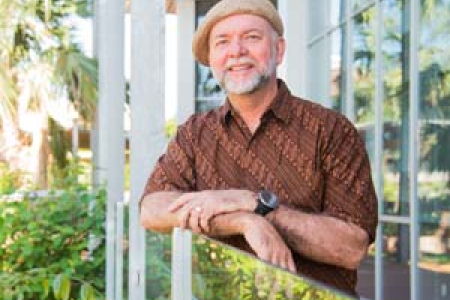Learning survival lessons in the wake of a tsunami
More than a decade after the tsunami that devastated the city of Banda Aceh on the Indonesian island of Sumatra, a Charles Darwin University student will travel to a nearby island close to the epicentre to discover why it largely avoided loss of lives in the disaster.
CDU PhD candidate and former bushfire manager Stephen Sutton will travel to Sinabang on the southern end of the island of Pulau Simeulue this weekend to talk to the community about how preparedness played a role in their survival.
“The island of Simeulue, 150 km off the coast of Sumatra, was the first location struck by the 2004 Indian Ocean tsunami but reportedly lost only a handful of lives,” Mr Sutton said. “In neighbouring Sumatra three per cent of the population died.”
With a background in archaeology and Indigenous heritage, Mr Sutton said he hoped to investigate and understand the social and environmental factors that led to such an outcome.
“Most research into disaster risk reduction focuses on the losses arising from bushfires and natural hazards and how to avoid similar losses in the future,” he said. “Very little research considers situations where losses have been avoided by effective practices. The really compelling thing about the story of Simeulue is the way the entire community responded to the disaster.”
As part of his PhD Mr Sutton will talk to the community in Sinabang and document the behaviours that contributed to averting devastating loss of life.
“I want to understand why this particular community prepared and what, if any, were the environmental or cultural signs,” he said.
Growing up in Coonabarabran, NSW where summers always threatened and sometimes delivered terrible bushfires, and as a former Director of Bushfires NT, he said he hoped this research would help discover some of the drivers that made people prepare for disaster.
“Often, and despite all the warnings, people don’t take an impending disaster seriously and fail to prepare,” Mr Sutton said. “In addition to studying why people don't prepare we should study why they do prepare.”
By identifying the cultural drivers of disaster risk reduction behaviour on Simeulue, he said he hoped to help identify opportunities to apply lessons for risk communication and disaster risk reduction in Australian contexts.
Mr Sutton has worked for more than 30 years in the areas of archaeology and Indigenous heritage, environmental management and impact assessment. During his role as head of Bushfires NT, he was involved in the disaster risk reduction actions following events including fires, cyclones (Monica, Helen and Carlos) and numerous flooding events and became interested in behaviours relating to disaster risk reduction.
His current interest in finding ways to develop community resilience through improved disaster risk reduction behaviour stems from his experiences with disaster management and risk communication in the NT and nationally.
